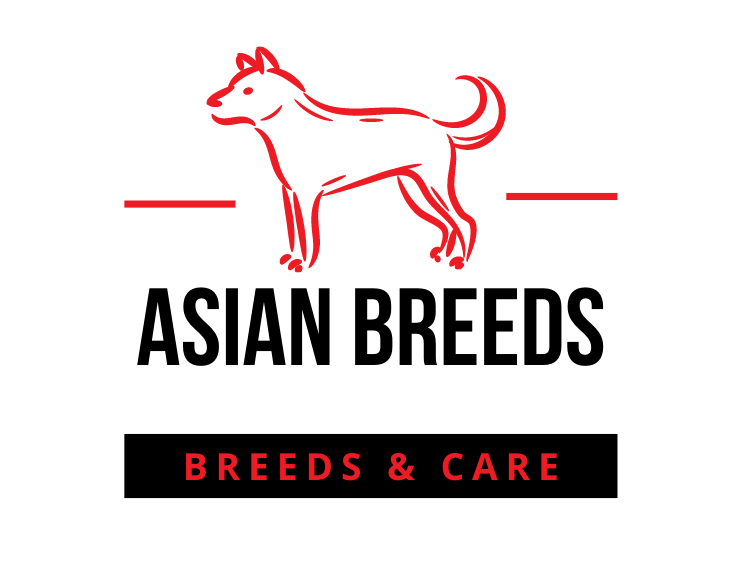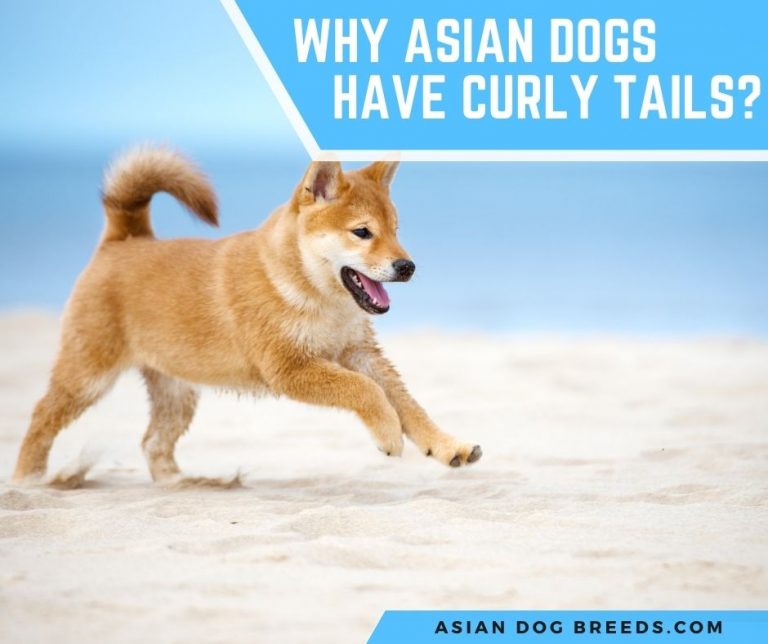Most dog breeds have their unique features which can range from their face shape to their size.
One of the special and distinct features of a dog is their tails. Dog tails are usually cute and charming especially when they are wagging very fast.
Dog’s tails can be long and straight, small to non-existent while others are curly.
Asian has produced lots of unique dog breeds over several centuries and there are lots of dog breeds with curly tails. You may be wondering why dogs have curly tails and why it is more common in Asian dog breeds.
This article will help shed more light on this topic as we will talk in-depth about everything that you need to know about dogs with curly tails.
Page Content
What Are Curly Tails In Dogs? Why Do Curly Tails Special?

The tail type of a dog is a result of evolution and selective breeding just like some dog breeds are large while some are small, and other dog features.
However, the tail is part of a dog’s spine. This means when your dog’s tail is curly, it means part of its spine is curved or bent.
Although this may look like something that you should panic about, curly tails are not usually problematic medically.
As stated above, curly tails are part of the breed standard. This is because continuous breeding can lead to the development of certain physical features.
Why do Asian dogs have curly tails?
The hemivertebrae is the major cause of curly tails in dogs and it simply means that the vertebrae of the dog are fused together or shaped like a wedge.
Curly tails are usually more common in Asian dog breeds and you don’t have to worry about this.
Do all Asian dog breeds have curly tails?

Although there are lots of Asian dog breeds with curly tails, you are still going to find some Asian dog breeds without curly tails.
Some of the common Asian dog breeds with curly tails are stated below.
Akita
Akita is an ancient dog breed with a mind-blowing feature.
They have a full tail that matches their thick double coat and they originate from Japan.
Akita dogs are usually alert and can bond very well with humans. However, they may not be very excited about other animals.
Pugs

The curly tail of a pug is unique and they are charming.
Pugs are available in several colors and you can easily find black, silver, or apricot-fawn pugs. Furthermore, pugs are cuter when they are wagging their curled tail.
The best thing is that pugs are a great companion and can adapt to several climates, animals, and humans.
However, you should note that they are usually food-motivated.
Pekingese
They are also called Pekes, sun dogs, or lion dogs and they were originally kept as companion pets to Chinese royals.
One of the fascinating stories about Pekingese is that they were created when Buddha shrunk a lion to small dog size.
They can grow to about 6-9 inches and weigh around 14 pounds. Pekingese are usually compact dogs with a flat face and thick double coat and you can easily identify them by their lion-like manes.
Pekingese are available in different colors as you can find them in sable, gold, red, grey, cream, black, or tan color.
Chow Chow
Chow Chows is another ancient Chinese dog breed on this list.
You will find it mesmerizing with its cute faces, fluffy coats, and curly tails.
Chow Chows can grow to about 17-20 inches and weigh between 40-70 pounds.
They are available in black, brown, cream, and red color variations.
Chow Chows can serve numerous purposes such as herd, sled, guard, and even hunt.
This dog breed may not be suitable for you if you are seeking a cuddle buddy.
However, with the right person, they are a perfect companion as they are very loyal to their owners.
Japanese Spitz
The Japanese Spitz is a comical dog breed which makes them a popular dog breed for the family.
Furthermore, they are people pleasers and you will feel like they are always smiling.
They are also perfect adventure buddies as they are very intelligent and loyal.
Although they have a white coat, they are ready to get it dirty when having fun.
Shiba Inu

This is another type of Japanese Spitz hunting dog.
Lots of their owners usually say they have a cat-like personality as they are quite independent, unlike other dog breeds. They are also regarded as an ancient dog breed like Basenji.
They were once used for flushing out birds and small game and even the occasional hunting of wild boar. However, Shibas Inu now serves primarily as companion dogs.
One of the things that you will like about this dog breed is their spirited personality.
Japanese Chin
Although this dog breed is named Japanese Chin, many believed that it actually originates from China.
Japanese Chin is popularly known for their cat-like behaviors and they are usually calm and affectionate.
Furthermore, they are a small and delicate dog breed with a round head, dark round eyes, and short snout which makes them charming.
They can grow to about 8-11 inches in height and weigh around 4-9 pounds.
Their coats are long and silky and they are available in lemon and white, black and white, sable and white, black, and several other colors.
Shih Tzus
This is a small toy dog and they are named because of their lion-like appearance.
They have a playful personality and they were treasured by Chinese nobility for centuries like Pekingese and pugs.
They were also crowned the noble dog of China.
You will be surprised to find out that they are sturdy toy dogs and they have flattened faces. They can grow to about 8-11 inches in height and weigh around 9-16 pounds.
Furthermore, they have a long and double coat and they are available in several color variations.
Xiasi Quan
The Xiasi Quan is also called Xiasi or Bai Long Quan.
They are medium-sized hunting dogs and can grow to about 17-20 inches in height and weigh about 22-60 pounds.
Xiasi Quan originates from Guizhou Province and are considered to be a lucky omen and bring wealth to the family.
They are quite affectionate and loyal to their owners.
You will find them cute with their short and wiry coat in white color.
They have a good hunting and guarding instincts with a great sense of smell and impeccable speed and stamina which makes them a perfect hunting dog.
Possible Signs That Your Dog Can Be Affected By Curly Tail
Here are some signs that your dog can be affected by the curly tail and once you notice this, you should try to take your dog to the vet.
Breed
After researching and you discover that your dog’s breed doesn’t have a curly tail, it is best to take it to the vet to help diagnose your dog.
Although, this may not be a big issue your vet can shed more light on why it happened to put your mind at ease.
Note: if you don’t know the breed of your dog, it may inherit curly tail genetically. However, puppies that are pure breed and the breed is not a curly-tailed breed should be a major concern to you.
Progression of Curl
If your dog has a curly tail when you adopt it, then it is a harmless genetic trait. However, if your dog’s tail becomes curly over time then it can mean that it has a degenerative or progressive spine issue.
Pain
Pain is a major way that you can check if your pet is doing all right.
You should be on the lookout whether your dog seems distressed or whether they are happy and cheerful most of the time.
This is because back problems can cause discomfort to your pet.
Spinal Problems In Dogs With Curly Tails
Instability can occur if there are malformed vertebrae in part of your dog’s spine beside the tail.
Some of the signs that you can notice when your dog has hemivertebrae are back pain, loss of feeling, wobbliness in the hind legs.
This can then lead to leg paralysis and the dog will not be able to control the excretion of urine and feces.
Dog breeds with corkscrew tails such as pug, French Bulldogs, etc. usually have spinal cord problems from hemivertebrae.
You will find signs of this problem when the pup is about 3-4 months old.
Hemivertebrae Treatment For Dogs With Curly Tails
The first thing to do is take your dog to the vet for x-rays to help confirm the diagnosis.
If your dog has mild cases, it may only need anti-inflammatory drugs to help reduce the pressure on the spine and swelling.
You can prevent hemivertebrae in dogs by making sure your dog does not do activities that can lead to unnecessary jolting.
Dogs that have severe signs can be treated with surgery. The surgeon will help to stabilize the spine using pins and/or wires.
Skin Infections In Dogs With Curly Tails.
Other problems that dogs with curly tails can develop are skin infections.
Dogs that have curly tails can have infections in their tail area. This can happen because of their skin fold form or due to their tightly curled tail.
This is because the skin area is usually moist and it is quite hard to clean them.
Furthermore, the tail is exposed to fecal matter that can help bacterial and fungi thrive.
You can easily avoid skin infections by having good hygienic practices with your dog.
You may need to help your puppy to clean and dry its rear end with a cotton ball after a bathroom trip.
Once your puppy shows any sign of infection, always take them to the vet to help determine what is causing the infection and the adequate treatment.
However, if your puppy gets infected regularly, your vet may advise that you amputate the tail.
Wrapping Up
Curly tail feature in dogs is usually breed-related just like dogs that have different kinds of coats, hair, or ears.
Curly tails are usually charming and they can captivate you as they look unique.
Although most Asian dogs have curly tails, there are several dogs of Asian descent with a curly tail as well.

